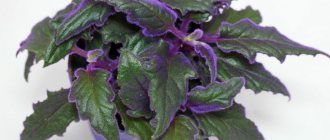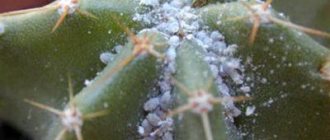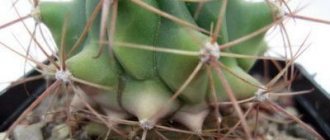Pros and cons of the method
Propagation of cactus by shoots has a number of advantages. This method is quite simple and economical. There are no special costs required for its implementation. However, there is always a risk that an exotic plant simply will not take root in its new environment. This is directly related to the fact that the shoot does not have its own roots.
Which cacti are best to keep at home?
A significant role of the cactus in the house is played by its appearance and shape. For example, tall columnar cacti can help when a person wants to get rid of excessive touchiness and emotional instability. Globular-shaped plants help to refrain from overeating. Cacti with finger-shaped stems are able to protect their owners from an evil tongue. In general, there is no particular reason not to keep this flower in the house. All this is quite individual: a plant that feels the love of its owners absorbs negative energy, returning only one positive energy. However, if one of the household members does not like the prickly plant, the cactus will try to “survive” him, causing him headaches or discomfort.
If, when thinking about the presence of this flower at home, you prefer a positive answer, it is advisable to place the pot on the windowsill or at the front door, most importantly, avoid placing it in the bedroom and children's room.
Choosing a time
You may be interested in: Violet Shulamith: description of the variety and photo
How to plant cacti at home? When is the best time to do this process? Let's look at this in more detail. Cactus cuttings can be planted throughout the year. However, the spring-summer period is more suitable for carrying out this procedure. The climate in the homeland of succulents is quite hot. Therefore, it is better if the length of daylight and temperature conditions are as close as possible to native weather conditions.
Like any other plant, cacti and succulents are in a phase of active vegetative development in the warm season. This will greatly facilitate the process of rooting the culture.
You may be interested in: Violet Sagittarius Elite: description, content
How to plant a cactus cutting in autumn or winter? In this case, you must remember that the young plant must be provided with the correct temperature and light conditions.
Is it possible to do this?
It is possible to prune cacti, and in some cases it is simply necessary.
It may be necessary to trim and re-root a cactus for various reasons, but most often this happens in cases where it is necessary:
- The plant begins to rot.
- The shape changes, the plant is greatly skewed.
- He has grown and stretched out a lot.
Cacti get sick due to inept care, pests or inappropriate treatment . Warm wintering, excessive watering or lack of light can seriously weaken the plant and reduce its ability to resist diseases and pests. To prevent this from happening, we suggest reading about how to properly water this plant and what is the best place to choose to place your green friend.
Rotting can begin due to:
- Overflow.
- Unsuitable soil (all details about choosing soil can be found here).
- A pot that is too large and where water stagnates (how to choose a pot for a cactus?).
- Due to fungal and bacterial infections.
Soil for planting
So what do you need to know about this? One of the most important points in answering the question of how to plant cacti is the correct choice of soil. Ordinary garden soil is not suitable for these purposes. You can buy substrate for succulents at a flower shop. It includes humus from turf and leaves, river sand, peat and other necessary nutrients. If you can’t purchase the mixture, you can try making the soil yourself. For this, garden soil, coarse sand and peat are taken. These components are combined in a ratio of 1:1:0.5. You can also add some foam balls and dry leaves to the soil.
Obtaining cactus seeds at home
You can get good planting material in the form of seeds from two flowering cacti grown from seeds or cuttings of different plants, but of the same variety. The main thing is not to miss the moment of flowering. When the flowers have bloomed, you should take a brush, bird feather or cotton swab and transfer pollen from one plant to another. If completed successfully, soon a berry will appear instead of a flower. You need to wait until it is completely ripe and extract the grains.
If planting seeds has to be postponed for some time, then paper bags will be the best place to store planting material.
Drainage system
Why is it needed? Without proper drainage, it will not be possible to grow a beautiful plant. It usually consists of a layer of materials that help drain excess water. Drainage should occupy from 1/5 to ½ of the container.
You may be interested in: Royal lace violet: growing features
It may include:
- pebbles;
- expanded clay;
- small pebbles;
- broken brick;
- chopped wine corks;
- broken foam.
Varieties of prickly pear
- Perhaps the most popular among houseplant lovers is the small-haired prickly pear. During the flowering period, it is densely covered with bright yellow flowers of medium size. Even her golden spines look very attractive.
- By the way, regarding the question of whether prickly pear is a houseplant or not: the garden queen of cacti can be grown both at home and in an open space, since it is not afraid of winter cold. Under a thick layer of snow (just think!) it successfully survives frosts down to 35 degrees. If you live in areas with little snow, then cover wintering prickly pears with thick film in the fall.
- Indian prickly pear (fig) blooms very profusely, and in place of each flower wonderful edible fruits ripen, similar in appearance to figs. Their taste is reminiscent of pear and strawberry.
- The Berger variety blooms with dense, bright red flowers.
- White-haired prickly pear delights with small bright yellow flowers that smell amazingly pleasant. This cactus will also give you very tasty fruits.
- In summer, the common eared grass is covered with large yellow flowers.
- The Subulata species is very different among its relatives due to its atypical shape. Its thick stems grow strictly perpendicularly, and their number increases over the years. The result is a lush bush of straight stems.
- Prickly pear is characterized by the splendor of its crown. Over the years, it takes on the appearance of a bush.
- How beautiful Gosselin's prickly pear looks! In maturity it is a dense bush. It blooms with large, very fragrant flowers of bright yellow color. Its stems may have a green or bluish color. To be more precise, a light coating gives the stems a blue appearance. If you erase it, the surface of the stems will turn out to be green.
- The queen cactus spreads its flat stems along the ground. In mid-July, these stems are covered with bright yellow flowers. Habitat: hot countries.
- Opuntia cylindrical pleases with orange, pink or red flowers. It can reach a height of six meters. This happens if the plant grows in open ground. In the room, the variety reaches a maximum height of 2 meters and does not bloom very thickly.
Selection of capacity
Another important issue that you have to decide when transplanting cacti is the selection of a pot. Experienced gardeners recommend planting succulents in plastic containers. Plastic does not change the temperature of the soil and does not absorb water. If you prefer environmentally friendly materials, you can use containers made of ceramics and clay. It is better to give preference to light-colored pots. The soil will heat up less in them.
How to plant a cactus without roots? Since the root system of these plants is very long, this fact should be taken into account when choosing dishes. Cramped and small pots are not suitable for replanting. It is better to use wide, deep containers in which the roots can receive sufficient nutrients and moisture. The main condition is the presence of drainage holes to drain excess liquid. In their absence, water accumulating at the bottom can cause rotting of the roots, and consequently the death of the entire plant.
Picking cacti or replanting them
After the seedlings have formed roots, it is necessary to transfer them to a deeper general container for further development. Healthy plants do not need to shorten the root system
It is important to plant the cactus correctly, since even a slight bend in the root can cause rotting. For this reason, non-standard ways of carrying out the procedure have been invented.
Picking cacti step by step:
- Place a drainage layer about 1 cm thick into a clean, disinfected container.
- Cover the top with a small amount of soil mixture.
- Place the container at an angle of about 30° so that the substrate does not crumble, but the seedlings can be placed on their side.
- Cover one wall with soil, lay a row of seedlings, taking into account further increase in size.
- Place the root collar on the soil surface and straighten the roots.
- Gently sprinkle the seedlings with soil mixture on the other side. Lay out the 2nd row and subsequent ones in the same way.
When transplanted by placing them on a hill, cacti often do not occupy a vertical position, so after filling the container, you need to straighten the seedlings using tweezers. Lightly compact the soil by tapping the edges of the container. Pour a small layer of river sand and allow the substrate to settle again.
There are several ways to plant a cactus at home. The absence of roots does not make the operation impossible, since the plant takes root well if basic agrotechnical recommendations are followed. Sowing seeds is also sometimes required, since over time the crop loses its decorative properties and becomes more susceptible to the effects of adverse environmental factors.
Choosing a sprout
How to plant cactus children? What you need to know about choosing shoots? Let's look at this in more detail. Before carrying out this procedure, it is extremely important to properly prepare the process. “Children” are formed on the cactus itself. They can be located both in the upper part of the plant and at the very roots. They are separated from the mother plant very simply, since they are practically not connected to the stem. The shoots of many types of succulents begin to produce roots while still on the adult plant. Over time, they may even fall off and fall to the ground, moving on to further development of the root system. Plant propagation occurs without any problems. When choosing a shoot for transplantation, you should definitely pay attention to its size: the larger it is, the better. Also take into account such an important point as the location of the process. According to experienced flower growers, better shoots are located closer to the top.
For planting cacti, you can also use “babies” without roots. This won't cause much difficulty. It is advisable to place the shoot in a dark, cool place for 3-7 days so that the cut dries out a little. This is done to prevent rotting.
How to properly plant a cactus with children
Seating children is the most acceptable method for a beginner. Suitable for those types of cacti that form these shoots. In some species they fall off on their own and take root after a while.
Children without roots are first placed in the substrate. Specimens with developed roots are planted directly in the ground.
Before planting a new young specimen in a pot, the children are rooted. The cut fragment is first slightly dried on a clean sheet of paper. To do this, be sure to choose a dark place.
The wider the cut area, the longer the process takes to dry. It takes at least 1-2 days for a dry callus to appear. If the children fall off on their own, rooting begins immediately. There are two ways to do this.
Placement in substrate
For rooting, take a small pot, which is only a couple of centimeters larger than the diameter of the shoot itself. During the process, it is very important that the water does not stagnate, otherwise the cut will rot. Therefore, the container must have drainage holes.
A slightly moist sandy mixture is used as soil (2 parts sand to 1 part soil). The spiny shoot is carefully applied with a cut to the surface. Please note that the section is not buried or covered with soil.
Watering is carried out especially carefully. A plant without roots easily moves and falls to the side. Perform the movements as carefully as possible, and do not move the pot until the roots appear. For stability, the baby is covered with small pebbles or vermiculite. Roots form after 7-12 days.
Rooting in a glass
Rooting directly in water is completely unsuitable. The cut rots long before roots form. There is an unusual rooting technology.
The shoot is attached to the glass so that the cut is at a distance of 5-6 cm above the water level. As water evaporates, carefully add water, bypassing the plant itself. The liquid temperature is maintained at 27-30 C.
The children are planted in pots after roots have formed. While the plants are small, one container is suitable for several specimens.
Instructions
It is advisable to familiarize yourself with this aspect first. So, how to divide a cactus when transplanting? Many novice gardeners are afraid to carry out this procedure on their own, although there is nothing complicated about it. Let's take a closer look at how to transplant cactus shoots without roots.
To separate the babies from the mother plant, it is better to use tweezers or a knife. It is especially important to consider this recommendation if you are going to plant a cactus with needles. Although the “babies” are not very firmly attached to the mother plant, the shoots should be separated with extreme caution. If the slightest particle remains in the cactus, it can lead to rot. As a result, the sprout will not take root.
It is better to prepare everything necessary for planting in advance. This is a container, soil, drainage, a spatula and the sprouts themselves. First, you should lay a drainage layer on the bottom of the container. The remaining space is filled with moistened soil. Make a small depression in the middle of the pot. The “baby” is placed in it without dropping it, cut side down. If there are roots, it is better to straighten them. Lightly press down the soil with your hands to secure the young plant. Under no circumstances bury the shoot deep into the ground. To prevent moisture from evaporating too intensely from the surface of the soil, you can place sea pebbles and stones on top of it.
When and how often to produce?
Rooting of cacti is most difficult in autumn and winter , when the plant is in a state of stagnation. But unfortunately, it is during these seasons that the plant’s immunity decreases and it is attacked by fungal and bacterial infections. Most often, the situation develops in such a way that pruning followed by rooting is the only way to save the plant from death.
If circumstances do not force you to immediately save the prickly succulent by pruning, you should wait until spring or summer. Cuttings cut this season will take root better, and the mother plant will survive.
Care
This aspect deserves special attention. Now that you understand how to plant cacti, it would be nice to know how to properly care for the plant at home. The first question that usually arises for novice gardeners is where to put the cactus pot. In this case, everything will depend on the type of succulent. So, cacti that grow in the desert are best placed in sunny places. Flower growers recommend providing partial shade to forest plants.
The cactus should not be watered for the first 5-7 days after planting. Simply spray the plant with water at room temperature. This will prevent it from drying out completely. Watering should start a little later. Make sure that the soil is not wet all the time; it should dry out slightly. The most optimal watering scheme is 2 times a week. Over time, the number of waterings can be reduced to once a week.
Treatment Options
Depending on the type of disease, there may be several treatment options.
Cutting off the roots
How to save a cactus if it begins to rot from below, sequence of actions:
- Cut off any roots that are severely affected or completely rotted.
- Rinse the remaining healthy roots in a solution of potassium permanganate.
- Sprinkle with sulfur powder or coal chips.
- Dry for 2-3 days, hanging in a vertical position.
- Take a new disinfected pot, pour steamed soil into it and plant the cactus.
- After planting, the plant does not need to be watered at all for 3-4 weeks.
Cutting off the roots
To avoid such a problem in the future, you must adhere to all watering rules.
Additional Information! Fungi have different modifications, but each of them will progress more strongly if the flower is in a cool room, and it is cloudy or raining outside at that time.
Re-rooting
If the root of a cactus has rotted, what to do in this case:
- Cut off the rotten piece and look carefully to ensure that the cut remains healthy and clean.
- The stem needs to be slightly “sharpened”, like a pencil, so that later it will be more convenient to plant it in the ground.
- Treat the cut with crushed activated carbon.
- Let it dry thoroughly by securing it in a vertical position or placing it on a plastic cup.
- Wait for the young roots to sprout. The process is quite lengthy and can take more than ten days.
- When the roots appear, plant the seedling in the ground for cacti.
- Water only through the tray. 10 minutes after watering, drain all the water from it.
Re-rooting process
The next time you can water only after 3-3.5 weeks.
Another way to revive a cactus if it has rotted:
- Cut off all the rotten part of the cactus.
- Dry for 3-4 days, during which time the cut should tighten.
- Treat with a root growth stimulator and place in a glass of water. You need enough water to cover the cut by 2-3 centimeters.
- After about 1-2 weeks, new roots will appear, when they reach 1 cm in length, the plant can be transplanted into new prepared soil.
A cactus transplanted in this way cannot be fed with fertilizers for one year.
Replanting a cactus
If there are pests or diseases, it is worth transplanting the flower into a new pot with new soil.
Transplanting into a new pot
The cactus is rotting from below, what to do in this case:
Shake the cactus out of the old pot, carefully examine the root and the trunk itself. Trim dried and damaged roots; if the stem is damaged, it must be cut back to healthy tissue, and the cut area should be sprinkled with crushed activated carbon. Next, the flower must be washed well in hot water (50-55 degrees), adding a fungicide or insecticide. Dry for 3-5 days in the sun in an upright position and with well-extended roots. Plant in the ground by placing the stem vertically in the pot and covering the roots with soil.
It is very important to ensure that the soil does not reach above the root collar. After such a cactus transplant, it must be kept in partial shade, without watering for about 3-5 days
After such a cactus transplant, it must be kept in partial shade, without watering, for about 3-5 days.
Note! When planting, it is important to ensure good drainage in the pot and add plenty of sand to the soil.
Trimming affected areas
How to save a cactus if it is affected by fungal rot:
- If the trunk of a cactus is affected, cut off the affected areas with a knife and treat with sulfur.
- If the top is affected, then it must be cut back to healthy tissue, and the plant itself must be used as a rootstock for grafting.
- If there is rot on the cactus, disinfect the wounds with charcoal or activated charcoal, or treat them with brilliant green.
During the period of treatment against fungi, it is necessary to exclude any spraying with water; it is better to use a fungicide solution for this purpose.
Treatment with drugs
For dry rot, brown spot and late blight, it is necessary to periodically (1-2 times a month) treat plants with phytoncides and insecticides.
With brown rot, if the cactus has become soft and watery, what to do:
- Heal all injuries on the cactus trunk.
- Adhere to the correct care regimen.
- Treat the plant with fungicides every 1-2 weeks.
Why doesn't the cactus take root?
Sometimes it happens that a plant dies after transplantation. Beginning gardeners often encounter this problem. This is usually due to errors in preparing the shoot or planting it. If the young crop is not dried well before planting in the ground, it will rot. You may have chosen a plant that is too young for replanting. In this case, it will most likely simply dry out and not sprout roots. It is also important to observe optimal growing conditions: the succulent should not be filled with water or placed in a cold and dark place.
How do you know when pruning is needed?
There are a number of external signs that allow you to understand whether the top of the plant can be trimmed:
- The skin turned yellow and stopped shining.
- The plant shrank.
- The cactus looked sideways.
- Spots appeared on the trunk (wet, dry, different in color and structure from the rest of the plant).
- Stopping growth and falling off during the growing season.
- The plant has become too long, heavy and threatens to overturn the pot.
- It rests on a shelf, a window sill, there is not enough space for it, it is not possible to move it to another.
Types of cacti
Let's look at this in more detail. The most popular types of cacti, photos and names of which can be found on resources of interest:
- Astrophytum: grows quite well. A distinctive feature of the culture is the presence of white flakes on the outside of the ribs. When flowering, beautiful yellow inflorescences are formed.
- Ferocactus: has hard, long spines. Usually this type of cacti has a cylindrical shape. It can reach 5-6 inches in height. “Children” often appear near the main trunk. In summer, large flowers may appear on adult specimens.
- Prickly pear: this type of cacti is characterized by its unpretentiousness and rapid growth. It is important to use gloves when caring for this plant, as it has very sharp spines. The peculiarity of this cactus is the presence of tiny, spiny bristles throughout the stem. They can cause much more inconvenience than the needles themselves, since they are very difficult to notice. There are different varieties of prickly pear: flat, oval, and so on. These cacti are characterized by their large size. They bloom unusually spectacularly. They bear edible pear-shaped fruits. The plants are quite hardy and can be planted even in open ground.
- Echinocereus: small spherical cacti covered with short spines. They bloom quite often with beautiful inflorescences. Caring for this type of cacti is very easy, so it is often recommended for beginners.
Features of cacti as plants
These representatives of the flora belong to succulent plants. That is, they are able to accumulate moisture in their powerful stem. Unlike other green organisms, they do not have leaves. The shoots are covered with hard or soft spines involved in photosynthesis.
The Cactus family is numerous, with over 2 thousand species, which are combined into 300 genera. America is considered the birthplace and main place of growth. Mexico, Chile, Argentina, Sri Lanka are rich in various species. They grow in arid desert areas and tropical jungles. Succulents survive in extreme conditions.
The trunk, also called the body, can grow to enormous sizes in the wild. The height of the stems sometimes reaches 10 m. The highest height recorded by scientists was 19 m.
The shoots grow very slowly, the annual growth is usually small. Along with giant succulents, there are also miniature specimens. The diameter of the Blossfeldia cactus reaches 1 cm.
Thorns are needed not only for protection from predatory animals, but also for protection from the sun. No matter how thick the spines are, they cast a shadow on the trunk. The thicker the layer the shoots are covered, the higher the preparedness for the scorching sun.
The skin is dense, practically impermeable to gases and liquids. Pubescence often plays the role of an absorbent sponge.
Another interesting feature of most species is that the thorny bushes do not form inflorescences; the flowers do not have a peduncle. The flower acts as a continuation of the stem. With excess feeding, some growing buds change into babies.
Flowering for these representatives of the flora is an unstable phenomenon. Some specimens bloom annually, others very rarely and only under very favorable conditions.
Some varieties are covered with flowers all over the top, creating a cap. The duration of flowering also varies. While some specimens have flowers that last for several weeks, others may close after a few hours.
Depending on the species, plants take on different shapes. The trunks are wrinkled, with ribs and tubercles. The ribs can be pronounced or barely noticeable, smooth or spiral-shaped. Plants are covered with different spines: dense, sparse, long, short, soft or hard.
A person needs to be careful with thorns. The needles can prick, and in some species they are a source of poison.
Caring for outdoor cacti (with photos)
All care for cacti in the summer comes down to watering during a long absence of rain, removing established weeds and mowing the grass around the hill. In summer, cacti are not closed even in prolonged cool and rainy weather. During the entire time the slide was maintained, not a single cactus died from this. Weeds, especially those with long rhizomes, can be quite annoying from time to time, so it is necessary to remove them immediately, when they first appear.
Water for irrigation should be soft enough: from a pond or other suitable body of water, but not from a well. In hot, dry weather, water in the evening. In cloudy weather, rain will fall on the cacti. You should not be afraid that the plants will be flooded; excess water will go through the drainage into the deeper layers of the soil. Over the years of keeping cacti outdoors, rotting of the roots from dampness has never been observed.
The growing season for cacti is short, and already at the end of August it is necessary to monitor the night temperature. If it begins to drop at night to 5-7 °C or lower, then it’s time to think about a film shelter of the same design as in the spring. The slide stones play a major role in maintaining the temperature under the film. Having warmed up during the day, especially on sunny days, under the film they retain heat until the morning. At this time and later, echinopsis and some mammillaria may still bloom. A two-layer film cover and a large mass of stones under it are so effective that in sunny weather, usually around the first frost, they allow cacti to maintain flowering until negative temperatures, at which a frozen crust forms on the ground in the morning.
In the conditions of the Moscow region, it was noted that a number of species can withstand frost of several degrees for a short time without consequences, even without film shelter. Of course, you shouldn’t delay winterizing cacti until frost, risking plants that took years to grow.
Before digging up cacti in the fall, you need to prepare a place where they will overwinter and special cassettes in which the plants are installed. The place should be bright and more or less cool, as when wintering a home collection. Cacti deprived of soil can tolerate fairly warm wintering without signs of growth. However, with excess heat and closer to spring, they can begin to grow early and even bloom. If there is a lack of light during this period, the stems will be damaged. However, there are usually no big problems with wintering cacti grown outside. Even small specimens survive the winter.
If the plants are large, you cannot do without a thick, thick mitten. It is impossible to hold a heavy and thorny plant with your bare hand. The soil after cacti is dug up and all roots, weeds and debris are removed from it. Partial or complete soil replacement is carried out in the spring.
Cassettes for winter maintenance of cacti are easiest to make from boxes of a suitable size made of corrugated cardboard. Round holes are cut out in the bottom of the box so that the roots of the cacti pass through them, and the stem rests on the edges of the hole. It is better if there is more space between the holes, taking into account future growth. To prevent the bottom of the box from sagging under the weight of cacti, it can be strengthened using wooden blocks or ordinary sticks of suitable diameter, passed through the holes in the side walls. Such cassettes last for years, and making them again is not difficult.
Before planting, garden cacti should be regularly sprayed with water, directly in the cassettes. Early flowering species (rebutia) can bloom in a cassette with dry roots. At this time, it is advisable to provide enough light to prevent the stems from stretching, and, if possible, raise the temperature. Under favorable weather conditions, cacti that have begun to swell are planted again in open ground.











